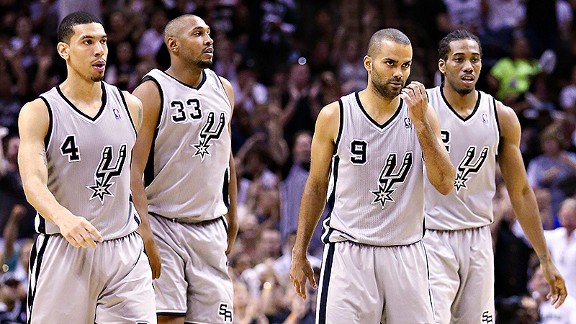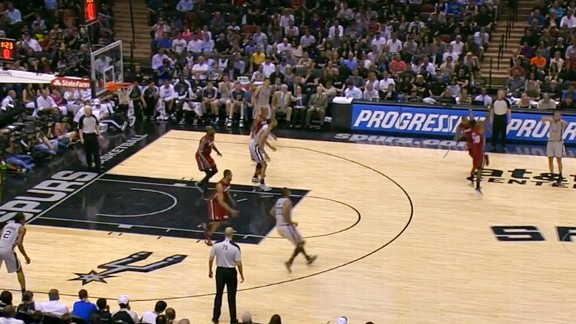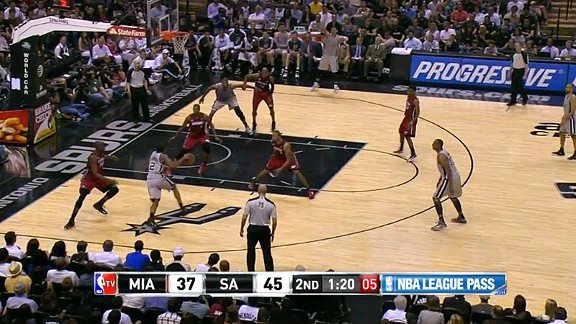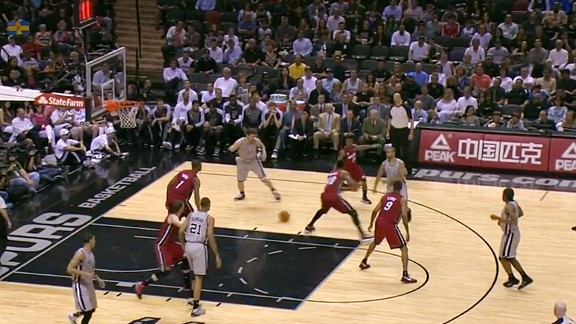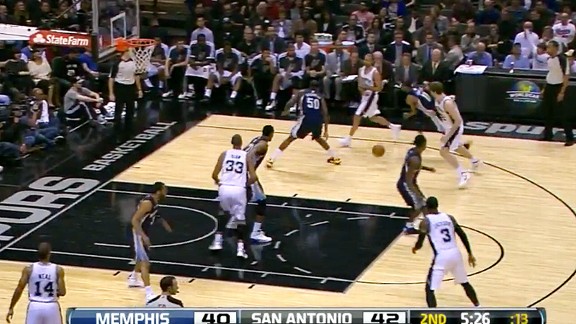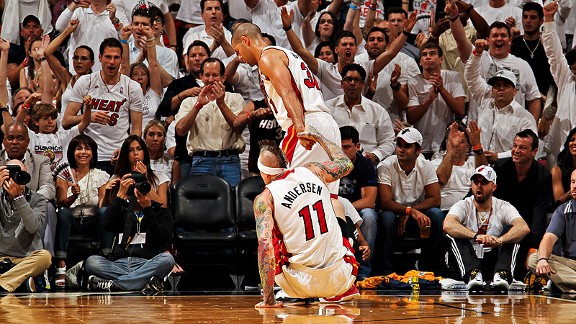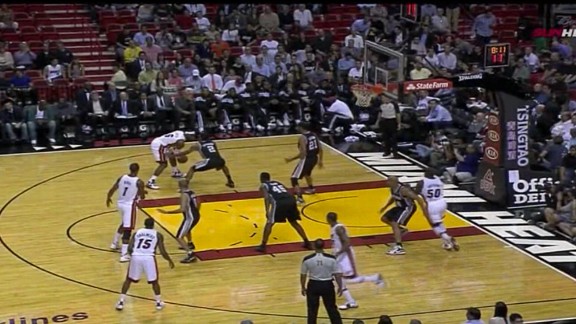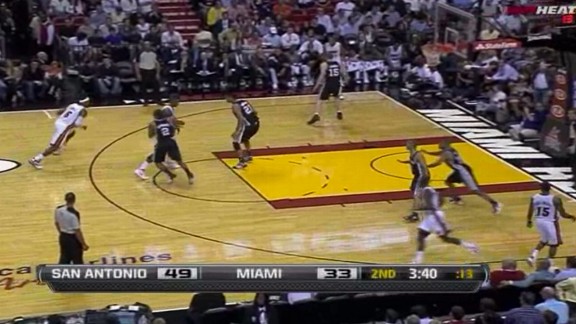How Healthy Are Dwyane Wade and Chris Bosh?
This is a question so fundamental it looms over everything. Miami is not Miami, on either end, if these guys can't attack the basket on offense, fly from outside-to-inside-to-outside on defense (Wade), and protect the rim (Bosh). Wade will have to defend Manu Ginobili in stretches, though James will get a slice of that assignment, and a healthy Wade should be able to work Ginobili and Green in the post. He'll also have to find smart cuts to the rim when the Spurs load up on LeBron, and when Wade gets his chance to shine in pick-and-rolls, he'll need some explosion to get to the rack against a San Antonio defense that will go under picks and try to turn him into a (bad) jump-shooter.
Watching clips of Bosh against the Spurs is almost jarring after watching him shoot 16 3-pointers in seven games against Indiana and fail to crack double figures in the last four. Bosh will get decent midrange looks in this series as a floor-stretcher, but in the past, he's been vicious attacking Duncan off the dribble, posting up Bonner, and going at Splitter all over the place. The Heat have actually called post-ups for him against San Antonio, and they've used other sets designed to get him moving into a dribble-drive. They tried to force this stuff down Bosh's throat in Game 7 against Indy, but he mostly missed near the basket. Can he finish against Duncan and Splitter better than he did against Roy Hibbert?
Bosh's deadly midrange shot provides the spacing that makes Miami's offense go, but the Heat are at their best when he sprinkles in some other Bosh-y things. San Antonio's defense does well limiting teams to midrange 2s, and if the Spurs nearly vaporize the Miller–Ray Allen–Shane Battier trio, as Indiana did, the Heat will have to play heavy minutes without much 3-point shooting. In that case, they'll need some rim attacks from both sub-LeBron stars.
Big or Small?
Small lineups with Battier at power forward have formed the core of Miami's identity since last season's conference finals. Battier's willingness to bang with Carlos Boozer/David West types spares LeBron that job and allows Miami to put killer shooting all over the floor.6
Indiana smushed those lineups under the feet of West and Hibbert, leaving Miami two choices: play two big men or slot Battier's minutes to Miller or Allen, a solution that allows them to remain small but also forces James to guard a big man.
Neither is an ideal solution long-term, even though Haslem magically discovered his midrange shot and Chris Andersen has been going Birdman on everyone for months. Miami's offense sings with an extra dose of shooting on the floor, but they'd prefer to inject that dosage without forcing LeBron to bang on the block for seven games.
The Pacers are gone; what happens now? Splitter is key again here. He has a tricky back-to-the-basket game, and though it's light on above-the-rim devastation, he'll lay a shoulder into a dude's chest if that gets him a step closer to the rim. Splitter's only a so-so offensive rebounder, and the Spurs have long punted offensive rebounding in order to get back on defense. If the Heat are confident Battier can handle Splitter — and I suspect they are — we'll likely see Battier reenter the rotation after working as LeBron's towel boy7 in Game 7 against the Pacers. Battier might also find the extra split second he needs to load up his 3-point shots, since the Spurs are not quite as long and speedy at the guard/wing positions as the Pacers.
Miller's earned another look with his recent shooting spree and general friskiness on defense,8 especially if Erik Spoelstra sees the finish line is close enough to grant LeBron more time guarding a big man. At the very least, the Heat should be ultra-comfortable going small whenever either Bonner or Diaw replaces one of the Duncan/Splitter combo.
The Spurs are versatile enough to respond in a variety of ways to whatever Miami does, and part of Gregg Popovich's job here is to find the right mix of responses. They can just stay big for 48 minutes; Splitter, Bonner, and Diaw should be fine hiding out on the least-threatening Miami perimeter player, just as West and Tyler Hansbrough did. They can also downsize and use Leonard as a small-ball power forward, and since the Heat typically offer two safe hiding places (their point guards and the Allen/Miller/Battier shooting spot), the Spurs can go small with both Parker and Gary Neal on the floor if they'd like — something that was trickier against Golden State in the second round. But such lineups have spent minimal time together; the promising Parker-Green-Ginobili-Leonard-Duncan group, for instance, is minus-33 over a paltry 75 minutes combined in the regular season and playoffs, per NBA.com.
The Spurs will go small. The key is how long they do it, how the lineups function, and whether the Spurs might even do so opportunistically, against Miami lineups featuring two big men. This'll be fun to watch.
Who Guards LeBron? And How?
Have fun, Kawhi. Leonard has played exactly one career game against LeBron, so we've no clue whether he's up for this. He has the tools, and he showed in that one game — in January of last season — that he can battle LeBron in the post and force him into some tricky shots. Green may also get a few chances since Leonard has to rest sometime, and the Spurs — absent a Tracy McGrady resurrection — have no true backup small forward.9
Leonard should be able to handle James without dramatic help, though the Spurs will send some swiping arms toward the post and occasionally overload the strong side against LeBron isolations:
But this is more about team versus team than Leonard versus LeBron. Simple high pick-and-rolls with James won't be good enough against the Spurs, just as they weren't against Indiana, even if Bosh can get all the pick-and-pop midrangers he likes. The Spurs on those plays will drop their big men back toward the paint, hoping to corral James before he gets to the basket:
LeBron has the tools to foil that strategy and get Duncan in foul trouble if he treats Duncan like Ian Mahinmi instead of Hibbert — that is, if he attacks the rim like a madman instead of worrying about getting his shot rejected. Duncan is a great defender and Splitter a good one, but they're not as big as Hibbert, and even Duncan doesn't protect the rim as well.10 LeBron should be in attack mode from the jump.
And the Heat can stymie that defense by rediscovering all the passing and cutting and misdirection and 3-point shooting that made their offense whir all season — a return to form that will be much easier if the Heat get back to small ball. They'll use some of the same sideline pick-and-rolls that hurt Indiana, and they can make Parker work by having Chalmers and Cole set picks for LeBron. Using LeBron as a screener is always a good idea, and in past meetings against the Spurs they have used the LeBron/Wade pick-and-roll — remember that? — to get some juicy switches.
Pace, Pace, Pace: Who Wins in Transition?
This is the one thing that jumps out from the head-to-head games between these teams: San Antonio is determined to find easy points in transition, and Parker especially has carte blanche to run his one-man fast break right at backpedaling defenders. Miami, for all its gifts, can get sloppy in transition defense. Wade is a chronic whiner, and that bad habit has rubbed off on LeBron. Chalmers will admire his shot now and then. You can get leak-outs against the Heat, and the Spurs will hunt for them. Green and Leonard know to sprint to the wings, and Ginobili is always looking to ease into a trailing 3-pointer.
The Spurs also love to run little stagger screens in transition for Ginobili, where two big men screen for him at once and then cut in different directions. "Those plays can be very tough to guard when one of the big men can pop out for 3-pointers," Bonner told me in Memphis last week.
Can the Heat Snuff Out Manu?
San Antonio's mad genius can catch a defense off-guard if he knows what's coming. He'll throw passes no one else tries, and he'll throw the standard ones a beat earlier or later than everyone else does. He's a savant, and the Spurs are a different team when he gets rolling.
Late-career Manu struggles to score consistently against top defenses, but he's shown this season, and especially in the playoffs, that he can still make an impact as a passer. If the Heat let Ginobili breathe up high on pick-and-rolls, he'll find ways to use Miami's aggression against them — including on this specific pass he's about to throw to George Hill (from an old Miami-Spurs game) in the corner:
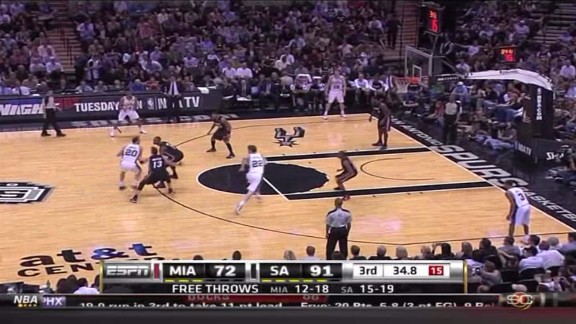
Like any smart pick-and-roll ball handler, Ginobili knows that standard pick-and-roll defense these days calls for the man guarding the shooter in the weakside corner (Hill in this photo) to crash into the lane and bump the big guy rolling to the hoop. Ginobili is also better than just about everyone at passing to that open shooter very early in the play, so that the defender's momentum is still going toward the middle while the pass is in the air. Ginobili will have a harder time making this pass if the Heat either amp up their aggression on the trap, forcing him backward and putting arms in the passing lane, or abandon the trap and have their big men stay close to the screen-setter.
Regardless: Letting Ginobili pick them apart is the worst choice.
Prediction
If we knew Wade and Bosh were at even 85 percent health, and that they'd stay there over the full series, this would be a confident call for Miami. The Spurs are fantastic, but the Heat have shown before that they can ramp up their athletic and coordinated fury to a level with which even the most polished teams cannot contend. They also have the world's greatest player. The Wade and Bosh we saw in Game 7 against Indiana would probably be enough.
But we don't know their health status, and we can't know it. Still, Miami has LeBron, home-court advantage, and a style of play that will challenge, and maybe even unnerve, San Antonio's secondary players.
Heat in 6.
 but i knew he wasnt gonna last
but i knew he wasnt gonna last 

 gotta be the best basketball analyst out there right now.
gotta be the best basketball analyst out there right now. 